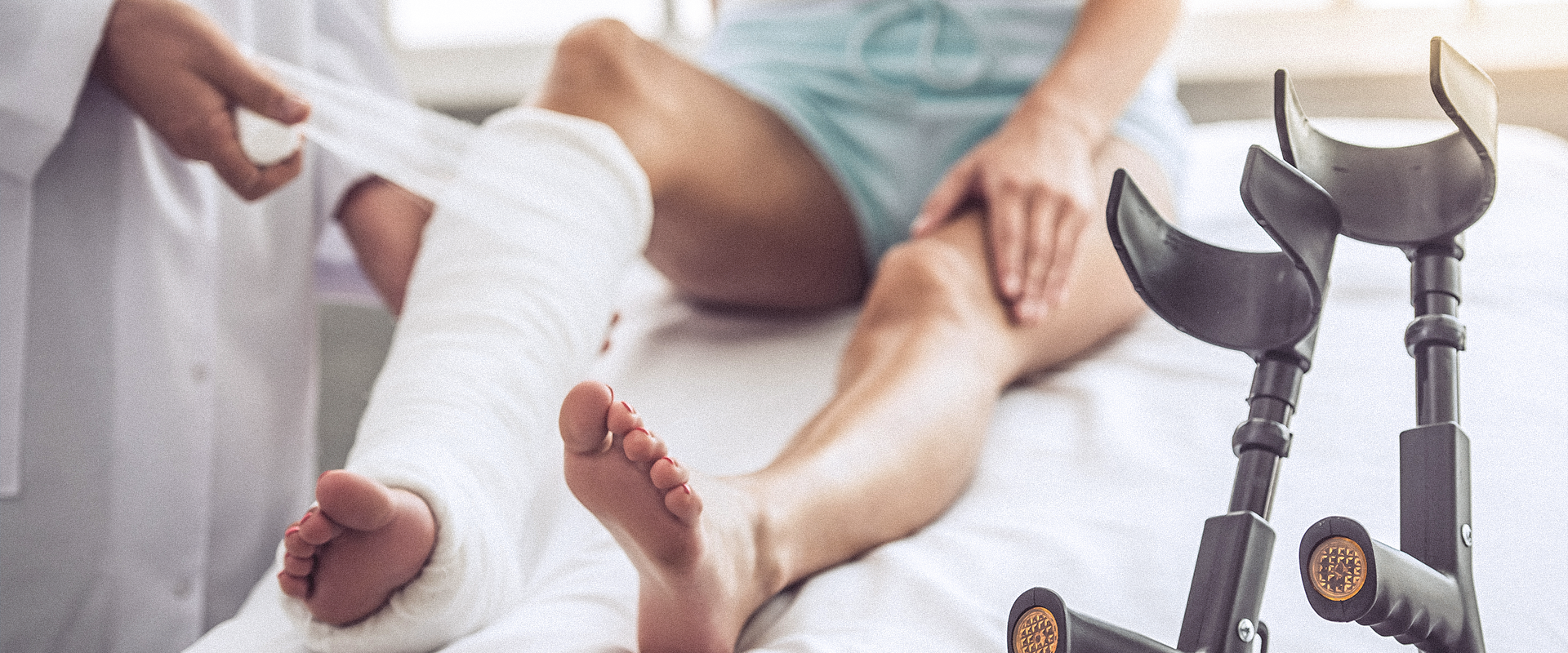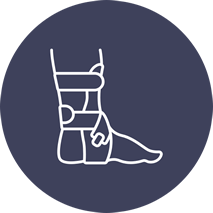
Physical Therapy for Broken Bones
AT EVOLVE
Physical Therapy for Broken Bones
HOW CAN PHYSICAL THERAPY HELP AFTER A BROKEN BONE?
Broken bones require evaluation and treatment by a physician but physical therapists play an important role in recovery from a broken bone. From the time immediately post-injury all the way up to your return to unrestricted activity, PT has a role to play in helping you get better. In most cases a broken bone requires immobilization or casting and in some cases, surgery. Whether you had surgery or not, however, as a broken bone heals, you may experience stiffness, pain, or weakness around the area of injury. Physical therapy can help relieve symptoms of pain and stiffness while restoring normal motion, strength and flexibility so you can get back to the activities you need and love to do.
WHAT DOES PHYSICAL THERAPY FOR A BROKEN BONE LOOK LIKE?
Physical therapy after a broken bone will look different depending on the stage of healing. No matter where you are in your recovery, however, my team of therapists and I will start by getting to know your concerns and goals and performing a thorough physical exam to determine what areas we should target with our physical therapy interventions. In the beginning you may be focused most on maintaining strength and flexibility in surrounding or adjacent areas and as your bone heals you will begin to perform carefully prescribed movements and exercises to help restore your prior level of function.
HOW LONG WILL I NEED PHYSICAL THERAPY?
The time it takes between injury and full recovery can vary greatly depending on the type and location of the bone break, whether surgery was used to stabilize the bone and personal health factors like bone density. With physical therapy, though, we can help you to learn to live with and compensate for the injury while it is healing and then work with you to facilitate full recovery from the bone break.
HOW DO BROKEN BONES COMMONLY OCCUR?
Broken bones, also known as bone fractures, result when a force is applied to the bone that is greater than it can withstand. While in most cases forces applied to a bone through daily activities and weight bearing actually strengthen a bone, a sudden powerful force that exceeds the bone’s tolerance will result in a fracture.
In most cases, a significant force is needed to fracture a bone such as the force that occurs during a fall or a car accident. Another category of fractures known as stress fractures can occur through repeated stress on the bone without sufficient recovery. A runner who is running high mileage may experience this type of fracture while training for a marathon. Decreased bone mineral density like that which occurs from osteoporosis can predispose a bone to fracture more easily.
HOW DO I KNOW THE BONE IS BROKEN?
In many cases there is no mistaking a broken bone. In other cases, however, it can be more difficult to distinguish a broken bone from say a sprain or a strain. In all but the most obvious cases, such as a compound fracture in which fragments of bone are protruding from the skin, imaging like x-rays or MRI is needed to confirm a fractured bone. Symptoms of a broken bone can include the following:
- Deformities of the bone (the area looks misshapen, the bone looks out of place or looks different than before the injury)
- Pain (ranging from moderate to severe) both at rest and with movement
- Difficulty or inability to move the affected area
- Pain with or inability to bear weight through the area
- Localized swelling
- Bruising
- Pain with palpation (touching) of the area
End Injury Progression
Physical therapy for broken bones has proven to slow and even stop back pain issues and injury progression in many cases.
Relieve Pain
The movements used in this technique can target your lower back, upper back, hips, shoulders, and neck helping you to manage pain during the course of your physical therapy treatments.
Improve Range of Motion
Posture awareness is an important area to focus on due to the fact that certain positions may cause you further back pain.
Restore Mobility
You can gain mobility and flexibility by taking part in the stretches and exercises as prescribed by your physical therapist.
TYPES OF BROKEN BONES
Physical Therapy for Broken Toes
Physical therapy for broken toes has proven to slow and even stop back pain issues and injury progression in many cases.
Physical Therapy for Broken Foot
Physical therapy for a broken foot has proven to slow and even stop back pain issues and injury progression in many cases.
Physical Therapy for Broken Ankles
Physical therapy for broken ankles has proven to slow and even stop back pain issues and injury progression in many cases.
Physical Therapy for Broken Legs
Physical therapy for broken legs has proven to slow and even stop back pain issues and injury progression in many cases.
Physical Therapy for Broken Knees
Physical therapy for broken knees has proven to slow and even stop back pain issues and injury progression in many cases.
Physical Therapy for Broken Hips
Physical therapy for a broken hip has proven to slow and even stop back pain issues and injury progression in many cases.
Physical Therapy for Broken Hands
Physical therapy for a broken hand has proven to slow and even stop back pain issues and injury progression in many cases.
Physical Therapy for Broken Fingers
Physical therapy for broken fingers has proven to slow and even stop back pain issues and injury progression in many cases.
Physical Therapy for Broken Wrist
Physical therapy for broken wrist has proven to slow and even stop back pain issues and injury progression in many cases.
Physical Therapy for Broken Elbow
Physical therapy for a broken elbow has proven to slow and even stop back pain issues and injury progression in many cases.
Physical Therapy for Broken Arm
Physical therapy for broken arm has proven to slow and even stop back pain issues and injury progression in many cases.
Physical Therapy for Broken Shoulders
Physical therapy for broken shoulders has proven to slow and even stop back pain issues and injury progression in many cases.
Physical Therapy for Broken Neck
Physical therapy for a broken neck has proven to slow and even stop back pain issues and injury progression in many cases.
Physical Therapy for Broken Back
Physical therapy for a broken back has proven to slow and even stop back pain issues and injury progression in many cases.
WHAT PHYSICAL THERAPY INTERVENTIONS ARE USED TO TREAT BONE FRACTURES?
Early treatment: Because reduced or non-weight bearing and oftentimes immobilization is needed to allow bone to heal, early physical therapy treatment will consist of a lot of education and training. Your PT may educate you on the use of ice and elevation to manage pain and swelling, on how to maintain your weight bearing restrictions while performing daily activities and on how to utilize assistive devices like crutches or a walker. They may also prescribe some exercises for you to perform with uninvolved areas of the body to prevent loss of strength and fitness.
Later treatment: When your doctor has determined that your bone has healed sufficiently, you will begin to perform exercises with the involved limb or area. Increasing weight bearing and learning to walk normally again is an important step in recovering from a lower body fracture. Stiffness and weakness are commonly seen in the area after immobilization and targeting these areas with PT can help you return to your previous level of activities.
You can expect to begin strengthening and possibly stretching the area around the fracture. Activities that slowly increase the stress and forces applied through the previously-fractured area can facilitate continued bone healing and prepare you to return to higher force activities like running and lifting. If you are recovering from a stress fracture your PT will educate you on how to reduce your risk of future bone stress injuries through proper training and diet.
If you have recently broken a bone, with the help of our skilled PTs you can feel confident you are doing everything possible to support your body’s healing process and facilitate long-term recovery. Call us today to learn more about our services and schedule an evaluation:
Mill Basin (located in Harbor Fitness)
6161 Strickland Ave
Brooklyn, NY 11234
Monday: 7am-8pm
Tuesday: 7am-8pm
Wednesday: 8am-5pm
Thursday: 7am-8pm
Friday: 8am-1pm
Park Slope (located in Harbor Fitness)
550 5th Ave.
Brooklyn, NY 11215
Monday: 9am-8pm
Tuesday: 8am-6pm
Wednesday: 9am-8pm
Thursday: 8am-6pm
Friday: 8am-3pm
Gravesend
372 Avenue U
Brooklyn, NY 11223
Monday-Thursday: 8am-8pm
Friday: 8am-3pm
Ready to take the next step to a healthier you?
Contact Us Today!
PHYSICAL THERAPY FOR BROKEN BONES AT EVOLVE!
Need Physical Therapy for Your Healing Broken Bones?
Let our caring and compassionate physical therapists help you with relieving pain while getting you back on your feet comfortably.
Call now to schedule your first PT consultation free of charge.
Call: 1-718-258-3300





















